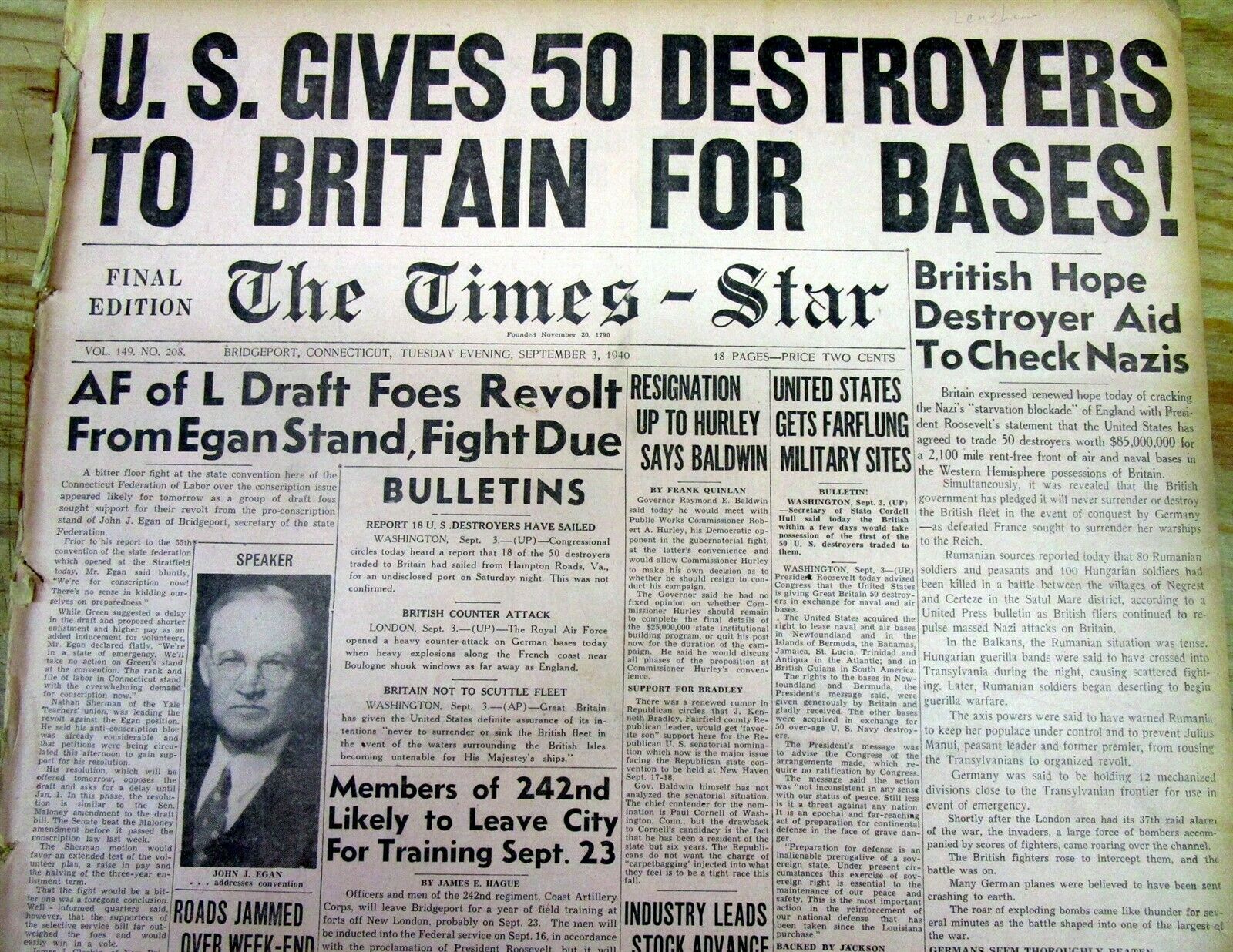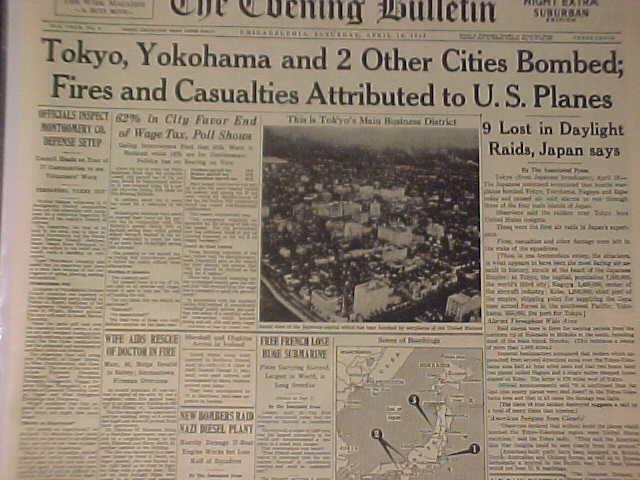-40%
1940 WW II hdln newspaper US TRADES 50 NAVY DESTROYER WARSHIPS for BRITISH BASES
$ 15.83
- Description
- Size Guide
Description
1940 WW II hdln newspaper US TRADES 50 NAVY DESTROYER WARSHIPS for BRITISH BASES1940 WW II headline display newspaper US TRADES 50 NAVY DESTROYER WARSHIPS for US access to BRITISH BASES
- inv # 9B-209
Please visit our
EBAY STORE
for THOUSANDS MORE HISTORICAL NEWSPAPERS for SALE or at auction
SEE PHOTO(s) - COMPLETE ORIGINAL NEWSPAPER, the
Bridgeport Times-Star
(CT) dated Sept 3, 1940. This original newspaper contains a prominent banner headline and long report of the
"DESTROYERS-FOR-BASES DEAL" between the US and Great Britain.
The destroyers-for-bases deal was an agreement between the United States and the United Kingdom on September 2, 1940, according to which 50 Caldwell, Wickes, and Clemson class US Navy destroyers were transferred to the Royal Navy from the United States Navy in exchange for land rights on British possessions.
Generally referred to as the "twelve hundred-ton type" (also known as "flush-deck", or "four-pipers" after their four funnels), the destroyers became the British Town class and were named after towns common to both the US and Britain. Roosevelt used an executive agreement that did not require Congressional approval, but he came under heavy attack from antiwar political elements. The agreement violated the Neutrality Acts.
By late June 1940, Germany had defeated France. The British and their Commonwealth and Empire stood alone in warfare against Hitler and Mussolini.
The British Chiefs of Staff Committee concluded in May that if France collapsed, "we do not think we could continue the war with any chance of success" without "full economic and financial support" from the United States of America.[3] Although the US government was sympathetic to Britain's plight, American public opinion at the time overwhelmingly supported isolationism to avoid US involvement in "another European war". Reflecting this sentiment, Congress had passed the Neutrality Acts three years previously, which banned the shipment or sale of arms from the US to any combatant nation. President Franklin D. Roosevelt was further constrained by the upcoming 1940 Presidential election, as his critics sought to portray him as being pro-war. Legal advice from the United States Justice Department stated that the transaction was legal.[4]
By late May, following the evacuation of British forces from Dunkirk, France, in Operation Dynamo, the Royal Navy was in immediate need of ships, especially as they were now fighting the Battle of the Atlantic in which German U-boats threatened Britain's supplies of food and other resources essential to the war effort.
With German troops advancing rapidly into France and many in the US Government convinced that the defeat of France and Britain was imminent, the US sent a proposal to London through the British Ambassador, the Marquess of Lothian, for an American lease of airfields on Trinidad, Bermuda, and Newfoundland.[5] British Prime Minister Winston Churchill initially rejected the offer on May 27 unless Britain received something immediate in return. On June 1, as the defeat of France loomed, President Roosevelt bypassed the Neutrality Act by declaring as "surplus" many millions of rounds of American ammunition and obsolescent small arms, and authorizing their shipment to the UK. Roosevelt rejected Churchill's pleas for destroyers for the Royal Navy.
By August, while Britain reached a low point, US Ambassador Joseph P. Kennedy reported from London that a British surrender was "inevitable". Seeking to persuade Roosevelt to send the destroyers, Churchill warned Roosevelt ominously that if Britain were vanquished, its colonial islands close to American shores could become a direct threat to America if they fell into German hands.
President Roosevelt approved the deal on the evening of August 30, 1940. On September 2, 1940, as the Battle of Britain intensified, Secretary of State Cordell Hull signaled agreement to the transfer of the warships to the Royal Navy. On September 3, 1940, Admiral Harold Stark certified that the destroyers were not vital to the security of the US. In exchange, the US was granted land in various British possessions for the establishment of naval or air bases with rent-free, 99-year leases, on:
Newfoundland
Eastern side of the Bahamas
Southern coast of Jamaica
Western coast of Saint Lucia
West coast of Trinidad (Gulf of Paria)
Antigua
British Guiana (present day Guyana) within fifty miles of Georgetown
The agreement also granted the US air and naval base rights in:
The Great Sound and Castle Harbour, Bermuda
South and eastern coasts of Newfoundland
No destroyers were received in exchange for the bases in Bermuda and Newfoundland. Both territories were vital to trans-Atlantic shipping, aviation, and to the Battle of the Atlantic. Although enemy attack on either was unlikely, it could not be discounted, and Britain had been forced to wastefully maintain defensive forces, including the Bermuda Garrison. The deal allowed Britain to hand much of the defence of Bermuda to the still-neutral US, freeing British forces for redeployment to more active theatres. It also enabled the development of strategic facilities at US expense which British forces would also use.
American and British sailors examine depth charges. In the background are US Wickes-class destroyers before their transfer
The Royal Air Force (RAF) and the Fleet Air Arm (FAA) each maintained air stations in Bermuda at the start of the war, but these only served flying boats. The RAF station on Darrell's Island served as a staging point for trans-Atlantic flights by RAF Transport Command and RAF Ferry Command, BOAC, and Pan-Am, as well as hosting the Bermuda Flying School, but did not operate maritime patrols. The FAA station on Boaz Island, existed to service aircraft based on vessels operating from or through the Royal Naval Dockyard, but attempted to maintain maritime patrols using pilots from naval ships, RAF Darrell's Island, and the Bermuda Flying School.
The agreement for bases in Bermuda stipulated that the US would, at its own expense, build an airfield, capable of handling large landplanes, which would be operated jointly by the US Army Air Force and the Royal Air Force. The airfield was named Kindley Field (after Field Kindley, an American aviator who fought for Britain during the First World War). RAF Transport Command relocated its operations to the airfield when it was completed in 1943, although RAF Ferry Command remained at Darrell's Island. Prior to this, the US Navy had established the Naval Operating Base at Bermuda's West End. This was a flying boat station, from which maritime patrols were operated for the remainder of the war (the US Navy had actually begun operating such patrols from RAF Darrell's Island, using floatplanes, while waiting for their own base to become operational). The RAF and FAA facilities were closed after the war, leaving only the US air bases in Bermuda. The Naval Operating Base ceased to be an air station in 1965, when its flying boats were replaced by Lockheed P-2 Neptunes, operating from the Kindley Air Force Base (as the former US Army airfield had become). These US air bases were in fact only two of several US military facilities that operated in Bermuda during the 20th Century. The US abandoned many of these bases in 1949 and the remaining few were closed in 1995.
Very good condition. This listing includes the complete entire original newspaper, NOT just a clipping or a page of it. STEPHEN A. GOLDMAN HISTORICAL NEWSPAPERS stands behind all of the items that we sell with a no questions asked, money back guarantee. Every item we sell is an original newspaper printed on the date indicated at the beginning of its description. U.S. buyers pay priority mail postage which includes waterproof plastic and a heavy cardboard flat to protect the purchased item from damage in the mail. Upon request by the buyer, we can ship by USPS Media Mail to reduce postage cost; however, please be aware that USPS Media Mail can be very slow in its time of transit to the buyer. International postage is quoted when we are informed as to where the package is to be sent. We do combine postage (to reduce postage costs) for multiple purchases sent in the same package.
We accept payment by PAYPAL as well as by CREDIT CARD (Visa and Master Card).
We list thousands of rare newspapers with dates from 1570 through 2004 on Ebay each week. This is truly SIX CENTURIES OF HISTORY that YOU CAN OWN!
Stephen A. Goldman Historical Newspapers has been in the business of buying and selling historical newspapers for over 50 years. Dr. Goldman is a consultant to the Freedom Forum Newseum and a member of the American Antiquarian Society. You can buy with confidence from us, knowing that we stand behind all of our historical items with a 100% money back guarantee. Let our 50+ years of experience work for YOU ! We have hundreds of thousands of historical newspapers (and their very early precursors) for sale.
Stephen A. Goldman Historical Newspapers
has been in the business of buying and selling historical newspapers for over 50 years. We are located in the charming Maryland Eastern Shore town of OXFORD, Maryland.
Dr. Goldman is a consultant to the Freedom Forum Newseum and a member of the American Antiquarian Society. You can buy with confidence from us, knowing that we stand behind all of our historical items with a 100% money back guarantee. Let our 50+ years of experience work for YOU ! We have hundreds of thousands of historical newspapers (and their very early precursors) for sale.
We invite customer requests for historical newspapers that are not yet located in our extensive Ebay listing of items. With an inventory of nearly a million historical newspapers (and their early precursors) we are likely have just the one
YOU
are searching for.
WE ARE ALSO ACTIVE BUYERS OF HISTORICAL NEWSPAPERS, including large and small personal collections, bound volumes, significant individual issues, or deaccessions from libraries and historical societies. IF YOU WANT TO SELL, WE WANT TO BUY !!!
Powered by SixBit's eCommerce Solution









